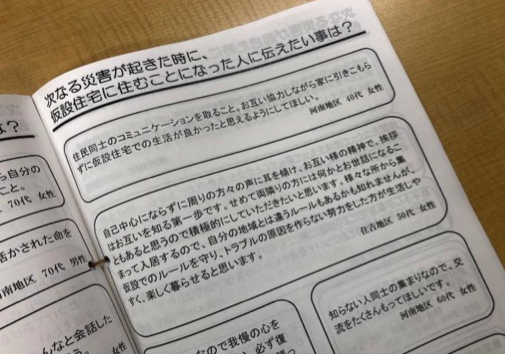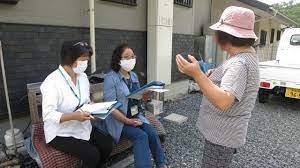Latest News
Temporary Housing Evaluation to Prepare for Future Disasters
“Where did you live before the disaster?”
“In which temporary housing were you placed?”
“What did you enjoy while living at your temporary housing?”
“What challenges did you face at the temporary housing?”

There are many questions asked on the questionnaire about living at temporary housing. Other questions include “To where are you relocating?” and “How would you describe the assistance you received during your stay at the temporary housing?”
With the questionnaires in hand, Ishinomaki Jichiren is conducting interviews with former temporary housing residents. Based in Ishinomaki, Miyagi Prefecture, Ishinomaki Jirchiren was founded in 2016 when the residents of the temporary housing began relocating to more permanent housing. With “no more lone deaths” as the motto, Ishinomaki Jichiren was founded to promote the prevention of lone deaths in the wake of disasters. Lone deaths increased after the 1995 Great Hanshin Earthquake and Ishinomaki Jichiren did not want the same tragedies repeated in Ishinomaki. The members include staff who were on a temporary housing association established in the fall of 2011.The association promoted cooperation and information sharing amongst different temporary housing groups and addressed challenges shared by the residents.

Ishinomaki Jichiren is now working on a temporary housing evaluation. Ishinomaki built temporary housing for over 7,000 households – the highest among the affected municipalities. The temporary housings were all dismantled by 2020, however, in-depth evaluation has not yet been conducted to capture what kind of challenges were observed by the residents.
“Japan has been hit by a series of natural disasters across the country since the Great East Japan Earthquake and hard infrastructure recovery has shown improvement. However, there is much more to be done for the soft components,” said Mr. Takuma Tagami of Ishimaki Jichiren. The soft component challenges include building a community in and outside of the temporary housing and inconveniences faced by temporary housing. Location and the way temporary housing way managed greatly affected the residents’ well-being and satisfaction over their lives. However, the actual situation has not yet been fully grasped. Mr. Tagami and his colleagues are hoping to reduce lonesomeness and lone deaths among disaster victims by conducting the temporary housing evaluation.
.jpg)
Passing down the memories as a theme for the Great East Japan Earthquake assistance program, Civic Force has been supporting Ishinomaki Jichiren since April 2020. Ishinomaki Jichiren’s evaluation project has been conducting interviews with temporary housing residents, community leaders, aid workers, and municipal workers. Ishinomaki Jichiren’s staff work in pairs to collect answers from 500 people. The findings will be assessed together with an expert and put together into a report to be shared with municipalities and aid organizations across Japan.
Jichiren decided to utilize a face-to-face interview method instead of distributing paper-based evaluation forms. Mr. Tagami said, “We cannot find out people’s true feelings from handing out an evaluation paper.” Evaluators begin their interviews by introducing themselves and engaging in casual conversation before asking more personal questions.
“Because our conversations often go from people’s experiences right after the disaster and living at the temporary housing to current struggles, it can easily take an hour or two to interview one person. It’s a long process but we learn something new as we talk to each individual. Everyone has different and unique stories to tell,” said Ms. Michiyo Oshima, one of the evaluators. Her job is not only to conduct interviews but also providing a listening ear to those who have gone through this tremendous journey.

-
Great East Japan Earthquake
Donate to this project
Bank Transfer
SUMITOMO MITSUI BANKING CORPORATION(SWIFT code:SMBCJPJT)
Aoyama Branch (Branch No. 258)
5-9-12, Minamiaoyama, Minato-ku, Tokyo, 107-0062, JapanACCOUNT NAME CIVIC FORCE
ACCOUNT NO.6953964
TomigayaOgawa Bldg.2F, 2-41-12 Tomigaya, Shibuya-ku, Tokyo, 151-0063, Japan*The account holder's names for the banks are "Civic Force" or "公益社団法人Civic Force シャ)シビックフォース".
**Please note that 15% of your donation will be allocated to general operating expenses.
Latest News







